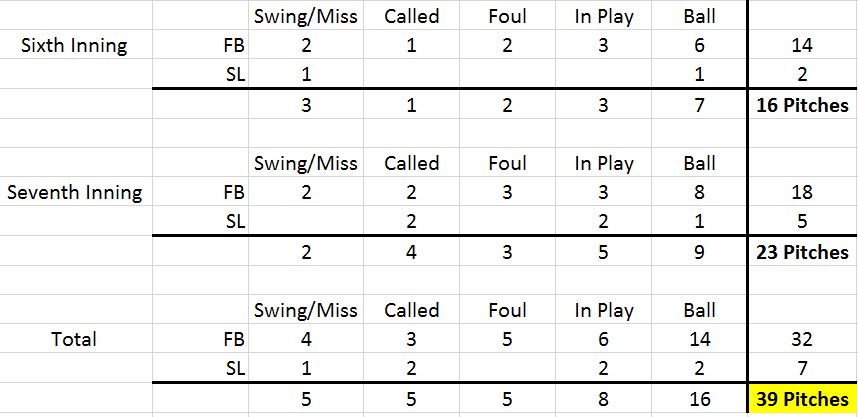As was the case with the Mets’ other trade deadline acquisitions, Ryder Ryan was thrust into action soon after the team struck the deal with the Cleveland Indians to obtain him. After he was swapped for Jay Bruce late Wednesday night and assigned to Low-A Columbia on Thursday, Ryder made his organizational debut on Friday in the Fireflies’ 15-2 loss at Spirit Communications Park.
Situation
Ryan entered in the top of the sixth inning of Columbia’s contest against Hickory, with the Crawdads already out to a 5-0 lead. While the 22-year-old may have been scheduled to pitch in this game regardless of the score, manager Jose Leger likely looked at the low-leverage conditions as a prime opportunity to get his first look at the newest Met.
Due up for Hickory was Tanner Gardner, Brendon Davis, and Eric Jenkins — the Crawdad’s 7-8-9 batters — who had combined to go 2-5 with a pair of runs batted in, when Ryan trotted in from the bullpen.
Breakdown
Ryan retired his first assignment with two fastballs in the zone, quickly inducing a lazy groundball to second base. Davis was able to send a 2-0 pitch for a single, putting two runners on for Ryan to deal with out of the gate. What stood out to me during this outing was just how calm and stone faced he looked while pitching from the stretch. A lot of times with young pitchers in the minor leagues, they tend to lose their pace and fail to repeat their mechanics after allowing batters to reach base. That never happened with Ryan during this game.
Ryan immediately came back and collected two swings and misses from Jenkins, followed by a shallow pop fly behind third base, where left fielder Jay Jabs raced in to make the grab. While the next batter, Crawdads leadoff man Blaine Prescott, walked up to the plate, Ryan was greeted on the mound by catcher Brandon Brosher, who approached him with a look as if to say “nice to meet you.” The Fireflies broadcast noted that Ryan had arrived in Columbia during the previous night’s game, but he was swamped with paperwork and other formalities.
Prescott worked a four-pitch walk in his plate appearance, watching a slider (Ryan’s first of night) and a trio of fastballs miss around the plate. The fourth wide one sailed near Prescott’s neck, but Brosher questionably had set the target letter-high.
Next up was Leody Taveras, the Texas Rangers’ top ranked prospect, according to MLB Pipeline. Ryan buckled down and pumped in two fastballs that Taveras was just able to make contact with, fouling both off. Looking at a 1-2 count, Ryan made a bold call, burying a tight slider in the dirt, and Taveras took the bait.
The Fireflies’ offense was silent in the bottom of the sixth, so Ryan was back out quickly to face Hickory’s 3-4-5 hitters. Andretty Cordero rolled over a slider to third base, and Ryan started off Alex Kowalczyk with the same pitch. Kowalczyk barely made contact with a 2-2 fastball, but he tapped it to shortstop and was given a hit on a ball first baseman Reed Gamache should have dug out of the dirt.
The next batter, Ricardo Valencia, made contact with a 2-2 slider out of the zone that a less experienced hitter probably doesn’t touch, and poked it into right field for a base hit. This play frustrated me when I saw it, because the second baseman, Luis Carpio, would have had a tailor made opportunity to turn an inning-ending double play on this ball, but he was standing right next to second base when the pitch was thrown. The defensive positioning here is confusing, because the batter, Valencia, has never attempted a stolen base in his six year career, so a double play would have been entirely possible, even if Carpio had been standing about 20 feet to his left.
With two on and one out, Anderson Tejeda, took advantage of the only mistake pitch Ryan made on the night, a first pitch fastball over the plate. Tejeda sent it about 340 feet over the right field fence, although it wasn’t hit all that hard, just straight up in the air. Again, if not for the missed opportunity on the previous play, Ryan would have been sitting in the dugout and his line would look a lot different.
Just like that, Ryan was facing Gardner again. On the fourth pitch of his at-bat, the left-handed batter socked a rope right to Carpio, who this time was exactly where he needed to be. Ryan’s last hurdle was Davis, who worked the count to 2-2. Ryan then broke off an excellent slider that froze him for strike three.
Final line: 2 IP, 4 H, 3 ER, 1 BB, 2 SO, 1 HR
Summary
This felt like a very productive outing for Ryan, who sat at 95-96 mph and topped out at 97. As you can see in the chart above, he was in or around the zone nearly the whole night, throwing both of his pitches for strikes. Going forward, Ryan will likely work on securing first pitch strikes, which he achieved only about 45% of the time.
As I mentioned above, Ryan’s composure will make him a pitching coach favorite. If he implodes, it will be because he got beat with his best stuff, not because he consistently misses his spots with runners on base. I counted maybe three instances where Brosher set up inside or outside, and Ryan hit the opposite.
Mechanically, Ryan is fluid and quiet, which has gotten him praise from scouts since his days at UNC. His motion does require him to dip lower than the normal 3/4 pitcher, so it will be crucial for Ryan to repeat his mechanics, as some of his pitches sailed high when he was more upright in his delivery.
Ryan’s stats will look ugly because of maybe three or four nightmare outings this season, but he clearly possesses the mental and physical edge to climb the minor league ladder. However, getting to the major leagues will be a long journey, and one that will require an extreme amount of fine tuning and development.




Well ya can’t teach 95-97mph. Wishing this pitcher all the best going forward.
There sure are a bunch of 91-93mph Mets relievers on the 25man currently. Could use more heat than just Robles.
Agreed. McGowen will help with the heat part. Smoker has been out of sorts this year but he can bring the gas. They have some guys who can sling it in Minors that should be up next season to help in BP.
“Ryan retired his first assignment with two fastballs in the zone, quickly inducing a lazy groundball to second base. Davis was able to send a 2-0 pitch for a single, putting two runners on for Ryan to deal with out of the gate”.
The lazy grounball to second should be out # 1 no??
The 2-0 pitch for a single should only put one man on with one out, not the two runners like you stated
Am I missing something?
You’re right, there was one on at that point, but two after the walk to Prescott. My apologies.